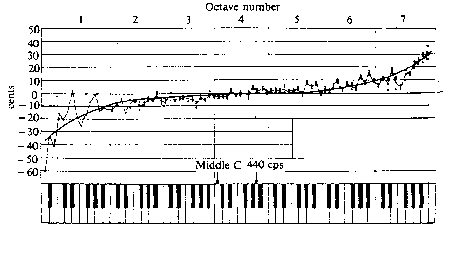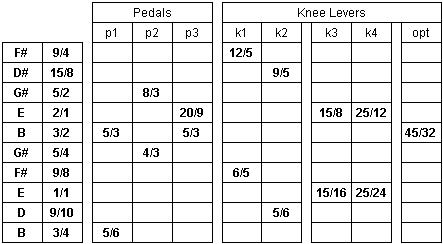<SMALL>I have yet to see a well known steel player say they tune every string and every pedal and knee lever to ET, and unless they do, it would appear to me their ear agrees with the principals of JI. -Reece Anderson-</SMALL>
Actually when I posted my
Armageddon query as a bush league bar/club/truckstop player, I had no idea that there were so many people that flattened or sharpened things to fit "their ears". I was
extremely surprised that I had company in not doing it for reasons other than simpleminded laziness.
<BLOCKQUOTE><font size="1" face="Verdana, Arial, Helvetica">quote:</font><HR><SMALL>My apologies for not explaining up front Bill, but I do tune
everything ET. Compensation is what I had to deal with tuning the old way but now it’s a thing of the past. I may go a cent or so flat in some cases but strictly to handle temp changes under certain conditions.
Also when I hear a JI steel third in a ET track, flat is the only word I can come up with. -Buddy Emmons-</SMALL><HR></BLOCKQUOTE>
<SMALL>I’ve tuned both ways an equal amount of years and the albums I’ve recorded over twenty years ago speak for the difference. My primary reason for tuning ET is to get everything out of the guitar that it’s capable of delivering. To me that’s what you should expect out of any musical instrument. Tuning ET has allowed me to use pedals and pedal combinations never before possible when I had to compromise. Besides, I figure if somebody can get away with tuning 9 cents flat to every other instrument, then I’m home free. -Buddy Emmons-</SMALL>
Of course it is an instrument that can move beatless chords "up and down". Correctly, the only one I know of. Certainly a Piano cannot do it without extremely complicated computer processing.
The limitation that seem to be glossed over is that there doesn't seem to be a comprehensive method, machine compensation system that allowes Beatlessness in every (more than three or at the most) pedal/lever inversion. If there is, I'd like to see it, or read it, and in the hundreds of Beatless Tuning posts I've read, I haven't read or even heard about "One". There's invariably more than one inversion that's unacceptably dissonant.
Also, the single notes, and moving chords, and/or partial chords, using pedals or knee levers to get one note out of the context of the "Beatless" chord that it is part of is a dissonance far greater than the "ET" by simple mechanical limitations.
Those are two central incongrueties of the "moving beatless chord".
The third is playing with fixed pitch instruments such as guitars and pianae.
Now, the way the "arguement" runs it's course typically, no matter how much simple information is put forth, ot how many others such as I post the "Stretch Tuning Chart for Piano Tuners" is getting predictable.
Somewhere after the second page, somebody kind of gets up, straightens their pants, yawns and says "It's all too complicated", and heads out of the day room.
Then, the hangers on that want the simple answers meet with fates that aren't quite so genteel.
"Oh Well", somebody says, "Even if you don't tune beatlessly, you play beatlessly".
What??
In my case, I watched a string of challenges, a series of snide remarks, stupid aspersions, and As Andy Griffith used to say, "I don't know what all...

". None of which affect the steady, low level, though well paid jobs that I have, or will continue getting.
Can I hear "out of tune stuff"?. Oh Mama! I've been listening to an "oldies station" that plays all the cover tunes from Eddy Rabbit, Reba, Charlie P, and others from the 70s and 80s. Mostly it's vocals, or obviously overdubbed studio licks and chords. It all fits WELL within what I consider to be good music. Certainly as well and better than I ever played most of it.
Do I agree that we should all just agree that there's too much tedious information, and that the enormity of it all makes it all useless to be able to say that you have a "simple method of tuning that you stand behind"?
No.
I'll stick with the way Mr Emmons tunes.
I've heard Mr Myrick tunes that way too.
It seems that Rick Schmidt tunes that way.
All the changes, All the strings, tuned straight up. Just like I have for 25 years.
Way before I knew that anybody either did or didn't.
If nothing else, I can always get a job playing
with the fat and the ugly... and there's
certainly nothing wrong with that 
.
I agree totally with everybody.
Especially at this holy time of the year.
Bless you all.
I'm praying for you.
Gotta do it at the gig though, I"m late..

Eric L.
PS. I wonder how Bobbe Seymour tunes....
<FONT SIZE=1 COLOR="#8e236b"><p align=CENTER>[This message was edited by Eric West on 03 December 2004 at 06:02 PM.]</p></FONT>

 <FONT SIZE=1 COLOR="#8e236b"><p align=CENTER>[This message was edited by Ron Sodos on 03 December 2004 at 11:04 AM.]</p></FONT>
<FONT SIZE=1 COLOR="#8e236b"><p align=CENTER>[This message was edited by Ron Sodos on 03 December 2004 at 11:04 AM.]</p></FONT> </SMALL><HR></BLOCKQUOTE>This shows how the "stretching" actually works. For more information, read
</SMALL><HR></BLOCKQUOTE>This shows how the "stretching" actually works. For more information, read 